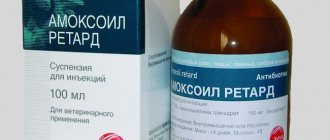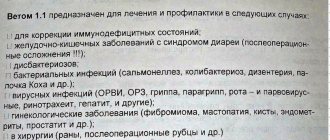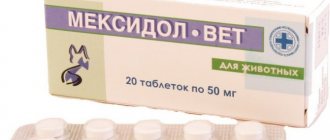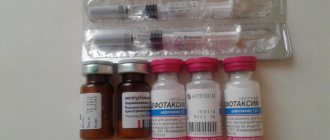Features of the drug Ciprovet
The main active ingredient of the antibiotic in the form of eye drops is ciprofloxacin; in the form of tablets, in addition to ciprofloxacin hydrochloride, the composition includes a prebiotic in the form of lactulose to protect the gastrointestinal tract.
Purpose
Ciprovet tablets for dogs are used to treat the respiratory and biliary tract, skin, joints, bones, soft tissues, stomach and intestines, as well as the genitourinary system from infectious diseases in both acute and chronic forms.
Ciprovet eye drops are prescribed for inflammatory processes that occur in the organs of vision. These are mainly keratitis, conjunctivitis, blepharitis, and corneal ulcers. The drug can also be used for inflammation of the eye appendages.
In surgery, these drops are used to prevent diseases before and after surgery. The antibiotic is also effective when foreign bodies get into the eyes and when the organs of vision are injured.
Ciprovet tablets are not recommended to be given to pregnant and lactating bitches, growing puppies, as well as to individuals with lesions of the central nervous system and cartilage tissue. The active substance does not combine with bacteriostatic antibiotics, theophylline, non-steroidal drugs, aluminum, magnesium, as well as calcium cations in the composition of other drugs. Antibiotics should not be given to animals with individual intolerance to fluoroquinolones.
Eye drops are not prescribed to animals with atherosclerosis or impaired blood circulation in the brain, as well as to puppies before the age of seven days. In most cases, there are no side effects from using eye drops. Sometimes conjunctival tenderness, itching, tearfulness, hyperemia and trembling may occur.
In animals sensitive to fluoroquinolones, when taking tablets, vomiting, loss of coordination of movements, trembling, refusal to feed and swelling occur. If symptoms occur, use should be stopped. The dosage calculation is 1 tablet per 10 kilograms of weight.
The pharmaceutical veterinary market is rich in antibacterial drugs, which differ in their principle of action, composition, and release form. It is important for the dog owner to understand that self-prescribing this or that medication is fraught with serious complications. However, it is still worth familiarizing yourself with the list of popular medications.
"Tsiprovet"
The tablets are effective for bronchitis, pneumonia and other viral diseases. In addition, the medication is active in cases of inflammation of the genitourinary system and infectious diseases of the gastrointestinal tract. The drug is also prescribed for lesions of soft tissues, bones, and joints.
"Amoxicillin"
A complex action drug that effectively destroys pathogenic bacteria and viruses. The product is produced in the format of injections, suspensions and tablets. The components of the medication are active in the case of diseases of the genitourinary system and gastrointestinal tract.
Injection dose: 1 ml per 10 kg of animal weight. The dose of tablets is calculated similarly. Amoxicillin is contraindicated in dogs that are intolerant to certain components of the drug.
"Amoxicillin" is a complex action drug
"Marfloxin"
The medication is available in the form of injections and tablets. The drug is prescribed for respiratory diseases, inflammation of the genitourinary system, and soft tissue lesions. Marfloxin is not prescribed to puppies under 1.5 years of age or to animals with congenital or acquired diseases of the central nervous system.
"Ceftriaxone"
This is a systemic antibiotic that has a prolonged bactericidal effect. Prescribed in case of otitis media, sepsis, inflammation of the brain, respiratory diseases, inflammation of the urinary tract.
"Ceftriaxone" is strictly contraindicated in pregnant and lactating dogs, puppies, as well as animals suffering from renal failure.
The product has a pronounced bactericidal effect, which consists in inhibiting protein synthesis in viral cells. The medicine is prescribed for infectious dermatological lesions, diseases of the genitourinary system, and respiratory diseases.
The drug is contraindicated in dogs sensitive to penicillin.
"Amoxiclav" has a pronounced bactericidal effect
"Betamox"
"Betamox" has a systemic prolonged effect. Effective in cases of diseases of the genitourinary system, gastrointestinal tract, infectious lesions of the respiratory system. "Betamox" injections are actively used in veterinary medicine for dermatological lesions of a bacterial nature.
"Gentamicin 8%"
The medicine is characterized by a pronounced antimicrobial effect. It is produced in the form of a solution for injection in a volume of 100 ml. The product is used to treat staphylococcal infections, diseases of the joints and bones, and inflammation of the genitourinary system.
"Engemicin"
The antibacterial medication is available in the form of an injection solution with a yellowish tint. The medicine has an antimicrobial effect. Prescribed for animals suffering from colds, infectious bronchitis, cystitis, pleurisy and their complications.
"Ceftriaxone"
An antibiotic with a medium toxicity class. Characterized by a prolonged antimicrobial effect. The drug is prescribed for otitis media, inflammation of the brain, sepsis, and bone tissue lesions.
"Ceftriaxone" is characterized by a prolonged antimicrobial effect
Overview of Antibiotics for Dogs
Tsiprovet
The drug is available in the form of eye drops and tablets. Drops are used to treat eye diseases of viral and bacterial origin. This can be conjunctivitis of various types, uevitis or blepharitis, as well as corneal ulcers.
Ciprovet in tablet form is prescribed to dogs for the treatment of viral bronchitis, pneumonia, and bronchopneumonia. The antibiotic is able to fight acute and chronic ailments of the excretory system and gastrointestinal tract. This drug is also used to treat bones, joints and soft tissues, as well as in case of secondary infection or complications of bacterial flora.
Tsiprovet is a safe and at the same time the most effective means of complex action.
Tsiprovet is not prescribed to pregnant and lactating females, as well as puppies under two months of age, as well as dogs with congenital or acquired pathologies of the central nervous system. Also, do not use the drug in case of intolerance to the components of the medication.
Amoxicillin
A universal drug with complex effects that can suppress the activity of various groups of pathogenic microorganisms, and then completely destroy them. The drug is well tolerated by dogs and other warm-blooded animals. Side effects occur in rare cases.
Available in the form of tablets and solution for injection.
Most often prescribed for the treatment of diseases of the gastrointestinal and respiratory tract, it is effective in combating inflammation of the excretory system and other viral ailments.
The injection solution is diluted at the rate of 1 ml of the drug per 10 kg of live weight, and the dosage of tablets is calculated in the same way. Injections can be given either intramuscularly or intravenously.
The medication is not prescribed if you are intolerant to the components of the drug, or in combination with antibiotics of the penicillin group.
Marfloxin
Available in the form of tablets and injection solutions. Prescribed for the treatment of soft tissue infections, diseases of the excretory system, respiratory diseases, as well as for wounds that are infected with bacterial flora.
Contraindications for use are the age of the puppy under one year, damage to the central nervous system, intolerance or sensitivity to the components. Also, Marfloxin is not prescribed simultaneously with cationic medications.
Ceftriaxone
This is a broad-spectrum drug that has a bactericidal, bacterioscopic effect (and a prolonged action). Particularly effective in the fight against penicillin-producing pathogens, gram-positive aerobic microorganisms, as well as strains producing penicillinase.
Dogs are prescribed for the treatment of otitis media, meningitis, as well as to eliminate inflammation of the respiratory and excretory tract, and skin diseases.
This antibiotic is often prescribed in the postoperative period to prevent complications.
The drug should not be used to treat dogs with kidney and liver failure, as well as pregnant females.
Amoxiclav tablets
This is a medicine of the penicillin group with a wide spectrum of action. It is characterized by a pronounced bactericidal effect.
Dogs are prescribed medication to treat respiratory infections, eliminate infections on the skin and soft tissues, as well as to eliminate ailments of the excretory system and gastrointestinal tract.
Course duration is 5-7 days. Not used to treat animals that are sensitive to penicillin.
Betamox
A complex, long-acting medication. prescribed to treat infections in the digestive tract. It fights well against respiratory ailments, respiratory tract infections, and diseases of the urinary system.
Betamox in the form of injections is used to treat wounds and trophic ulcers, dermatitis, soft tissue lesions that are caused by pathogenic flora that are sensitive to amoxicillin.
Gentamicin 4%
Available in the form of a solution in ampoules of 100 ml. The active ingredient is gentamicin sulfate.
Most often, the drug is prescribed for streptococcal and staphylococcal infections, as well as for the destruction of Escherichia coli or Pseudomonas aeruginosa. The drug also works well against diseases of bones and joints: arthritis, arthrosis. They can be prescribed for pleurisy, peritonitis, endometritis, as well as cystitis and pericarditis.
The drug should not be prescribed simultaneously with diuretics and muscle relaxants. Also, the drug should not be prescribed to animals with renal and hepatic insufficiency.
Engemicin
An antibacterial drug that has a powerful antimicrobial effect. Available in the form of an injection solution (light yellow liquid).
Dogs are prescribed for the treatment and prevention of infectious diseases that were caused by pathogenic gram-positive, gram-negative microorganisms (rickettsia, mycoplasma, chlamydia) that are sensitive to oxytetracycline.
When and how to use antibiotics
First of all, dog owners need to understand that using antibiotics without the recommendation of a veterinarian is very dangerous, because you need to know what caused the infection and choose a drug from the appropriate group.
What should an owner who does not have a medical education know about antibiotics for dogs? Only general information about such products and their use. It is necessary to take into account all the subtleties of using drugs for this purpose:
- If an animal has a disease of viral origin, then antibiotics are used only in case of complications or their threat.
- The dosage is calculated based on the weight of the pet, and in no case should you change it yourself, otherwise it can cause harm to health. An incorrect dosage may lead to intoxication of the pet, or the product may not work against the infection.
- Even if the dog feels significantly better, it is not recommended to stop the course of antibiotics. The number of days you are prescribed to take the medicine is the number you need to take.
- When choosing a remedy on your own, you can make a mistake, because there are many antibiotics that act on various infectious agents. The wrong drug will not help your pet and will take away valuable time, which can lead to significant complications.
- An overdose of the drug, in most cases, manifests itself in the form of vomiting and diarrhea, but sometimes more serious side effects are possible, for example, the pet may go deaf.
In the modern world, they have stopped paying attention to the fact that antibiotics should be prescribed only in extreme cases. Many owners, at the slightest manifestation of the disease, without any particular reason, use them.
This attitude towards medications leads to resistance of pathogens to antibacterial agents. This phenomenon occurs if you reduce the dose of the drug or stop taking the medication before the end of the course.
Very often, owners are interested in whether dogs can be given antibiotics intended for humans. But in fact, there are no special dog antibiotics. What is sold in veterinary pharmacies are the same products, but with a lower dosage.
The following groups of antibiotic drugs can be used in the therapy of dogs:
- Antibiotics belonging to the penicillin series, including those of semi-synthetic origin - Ampicillin, Flemoxin Solutab, Amoxicillin, Amoxiclav, etc.
- Cephalosporins - there are four generations of drugs and the more modern the generation, the more effective the drug against gram-negative flora. Pseudomonas aeruginosa and Escherichia coli are particularly resistant to antibiotics.
- Macrolides - Erythromycin, Clarithromycin, Macropen, Azithromycin, Spiramycin, etc. In most cases, they are used for diseases of the respiratory tract and pneumonia.
- Carbapenems - Meropenem, Meronem, Doripenem, Imipinem, etc. They are highly effective against staphylococci.
- Tetracyclines – natural: Tetracycline, Terramycin, Biomycin, and semi-synthetic: Metacycline, Doxycycline, Clinomycin. Used for tick-borne borreliosis and cystitis in dogs.
- Aminoglycosides - Tobramycin, Gentamicin, Kanamycin, Amikacin. They are effective against gram-negative pathogens and are highly toxic, so they are used exclusively for indications.
- Levomycetins - used for intestinal disorders.
- Fluoroquinolones – Ofloxacin, Pefloxacin, Ciprofloxacin, Levoflox, Levofloxacin. Used to treat cystitis, gastrointestinal infections, severe forms of pneumonia.
- Fungicidal antibiotics - Nystatin, Levorin, Amphoterecin B, are used only against the elimination of pathogenic fungi.
DETAILS: The best antibiotic for children is effective, safe, convenient
There is another group of antibiotics - anti-tuberculosis drugs (Streptomycin, Isoniazid, Rifampicin, Ftivazid). This group is intended for the treatment of people, but is extremely dangerous for animals. After taking them, the dog may not survive.
Antibiotics used for pets have different effects on infectious agents - bacteriostatic, in which they slow down and stop the growth of bacteria, or bactericidal, killing them.
In severe infectious diseases, especially those caused by gram-negative pathogens, it is recommended to begin antibiotic therapy with drugs that have a bacteriostatic effect. This will help avoid infectious-toxic shock, which is caused by a large intake of toxic substances released by dead bacteria into the blood.
Infectious agents quickly develop resistance to these types of drugs, so you should not abuse them.
If it is not possible to immediately identify the cause of the infection, then antibiotic drugs are prescribed, which have a fairly wide range of applications, since they are effective against various pathogenic microorganisms.
There are also general antibiotics; they can penetrate the tissues of various organs and systems, or agents that act only in the intestines.
There are many canine ailments that require the use of antibiotics and it is worth taking a closer look at when and what is used to treat pets.
The most commonly prescribed are semisynthetic penicillin antibiotics and cephalosporins. The other groups of drugs are used in therapy much less frequently, usually when the former are low in effectiveness.
- For purulent wounds or skin diseases, ointments with an antibacterial effect are prescribed. If we are talking about a puppy or large lesions, then antibiotics in the form of injections are added to the treatment. Since in this case almost any microorganisms can penetrate the body, broad-spectrum agents (Ceftriaxone, Cefotoxime) are used, which have an effect on both gram-positive and gram-negative flora.
- For complicated pneumonia, a course of penicillins – Amoxicillin, Cefazolin, or fluoroquinolones – Ofloxacin, Ciprovet – is often prescribed.
- To combat otitis media, drops containing an antibiotic are prescribed, intended for the treatment of domestic animals - Otibiovin, Otovedin, Surolan. If the disease is severe, additional special antibiotics are used in tablets or injections, for example, the drug Sinulox or Noroclav, which contain amoxicillin and clavulanic acid. They can be replaced with drugs such as Amoxicillin, Amoxiclav.
- Cystitis in pets is quite complicated and requires the use of antibiotics. In this case, a drug with a urological effect from the group of IV generation cephalosporins, Kabactan, has proven itself well. For this disease, fluoroquinolone antibiotics can be used, but they will only have a bacteriostatic effect.
- Fluoroquinolones and cephalosporins of the III and IV generations are prescribed for mastitis or postpartum endometritis in females, inflammatory processes in the paraanal glands. In this case, it is more effective to administer the drug by injection.
- Dogs often suffer from eye diseases - purulent conjunctivitis, blepharitis, keratitis, keratoconjunctivitis. Special drops for dogs Ciprovet, Tsifran, Tsifrolon, containing an antibiotic, help well against these ailments.
- One of the most common and terrible dog diseases is distemper; it is useless to treat with antibiotics, since it is of viral origin.
If your pet is prescribed tablets, they are given whole or crushed. It is not recommended to mix them with food, as this will reduce the effectiveness of the drug.
Only a veterinarian can decide which antibiotic to take and in what case. Self-prescribing and treating a pet with antibiotics is fraught with disastrous consequences, including death.
Categories: Veterinary |
by Male
Amoxicillin
The drug against infections is aimed at combating various microorganisms. Excellently absorbed and sensitive to stomach acids. Available in the form of tablets (250 and 500 ml) and injection suspensions (15% and 20%).
Purpose
In veterinary practice, the drug Amoxicillin is used for infections that were caused by microorganisms sensitive to this substance in the gastrointestinal tract, genitourinary system, as well as for respiratory diseases and in surgery.
This drug is effective for the following common diseases:
- leptospirosis;
- bronchitis, rhinitis;
- cystitis, endometritis, pyelonephritis;
- gastroenteritis.
The use of antibiotics to treat dogs
Antibacterial drugs are prescribed by a veterinarian. The necessary medicine, its dosage and the duration of the course of treatment are determined based on the diagnosis of the sick animal.
To do this, a microbiological examination of the dog’s secretions is carried out, a blood test is performed to determine the number of leukocytes, which indicate the presence of infection in the body, and X-rays are taken. In addition, the condition of the animal is important: body temperature, appetite, behavior.
Antibacterial drugs are prescribed by a veterinarian
It should be remembered that antibiotics are not effective against parasitic and viral diseases.
The drugs are indicated in the following situations:
- bacterial eye diseases;
- otitis;
- cystitis;
- mastitis;
- urethritis;
- kidney inflammation;
- staphylococcus;
- open wounds;
- endometritis;
- subcutaneous inflammation;
- pneumonia.
In case of non-compliance with the prescribed dosage or intolerance to the components of the drug, the following side effects may occur:
- nausea and vomiting;
- loss of appetite;
- apathy;
- diarrhea;
- allergy.
The main contraindications to the use of most antibacterial agents are pregnancy, lactation, young age (up to one and a half years), and individual intolerance.
The use of antibiotics significantly alleviates the course of the disease and leads to a speedy recovery of the pet. But it is strictly not recommended for a dog owner to prescribe the medicine on his own. The incompetence of the owner can cost the health or even the life of the animal.
Antibiotics are chemicals that inhibit the growth of microorganisms. They are included in medicines to combat bacterial infections, fungal diseases, and malignant neoplasms.
DETAILS: Treatment of chronic endometritis with antibiotics
They are also used for viruses, but as an additional drug to get rid of associated symptoms and diseases. Widely used in veterinary practice, in particular in the treatment of domestic and farm animals.
Various drugs are used for dogs, they are similar to human ones. The only significant difference is the dosage. Modern drugs can effectively cope with a number of serious diseases. The most commonly used antibiotics for dogs are:
- quinolones (example of active substance: ciprofloxacin);
- cephalosporins (ceftriaxone);
- penicillins (amoxicillin);
- tetracyclines (tetracycline);
- aminoglycosides (gentamicin).
All antibiotics in veterinary and human medicine are divided into 2 groups according to the principle of action. The first includes bacteriostatic substances that suppress the proliferation of microorganisms, but do not completely destroy them.
Those in the second group kill bacteria, which the body then removes naturally. Also, each series has its own mechanism of action. For example, penicillins affect the cell membrane of a microorganism, causing it to die, and tetracyclines inhibit protein synthesis.
Other important features include the purpose of the substance. It depends on different mechanisms of operation which bacteria will be sensitive to a particular drug. However, there are broad-spectrum antibiotics used for dogs, such as amoxicillin and ceftriaxone.
Their use is justified when the disease is difficult to determine or it is necessary to urgently remove life-threatening symptoms. Any antibiotics are prescribed only by a veterinarian, otherwise serious complications, including death, are possible.
It all depends on the disease and its manifestations, as well as the type of antibiotics. In general, they can be given orally (tablets, suspensions, some solutions), intramuscular, subcutaneous and intravenous injections, dripped onto mucous membranes, applied and sprinkled on the skin (ointments, powders).
The latter option is suitable for small wounds or local inflammation due to infections. The most effective method is intravenous injections, but they have complications, so administering antibiotics this way is best left to veterinarians or paramedics.
An alternative option is to crush the tablet and mix it with a small amount of water, place the solution in a special syringe or a regular one (5 ml) without a needle and inject the product onto the root of the tongue.
Indications for the use of antibiotics
Antibacterial drugs are prescribed by a veterinarian. The necessary medicine, its dosage and the duration of the course of treatment are determined based on the diagnosis of the sick animal.
To do this, a microbiological examination of the dog’s secretions is carried out, a blood test is performed to determine the number of leukocytes, which indicate the presence of infection in the body, and X-rays are taken. In addition, the condition of the animal is important: body temperature, appetite, behavior.
Antibacterial drugs are prescribed by a veterinarian
It should be remembered that antibiotics are not effective against parasitic and viral diseases.
The drugs are indicated in the following situations:
How to give an antibiotic to a dog?
Most often, tablets are given to dogs in crushed or whole form, mixed with food. First, the animal is given a little food or treat without medicine, so that the pet does not suspect something is wrong. Then you can give a piece of biscuits, meat, food or something else tasty with a piece of tablet.
You can also place the tablet on the root of the tongue, after which the pet will be forced to swallow it. This route should be chosen if the medicine cannot be given with food. The instructions for use of Tsiprovet, Amoxicillin and Marfloxin do not include contraindications in this regard.
The dog needs to be called in a gentle voice in a convenient place, carefully secured and a tablet placed in the mouth. Once you place it on the back of your tongue, close your jaws and pet your dog. If your pet begins to tremble throughout his body, then it is necessary to calm the animal in all possible ways.
In this video you can see how to give a pill to a dog correctly.
It is not recommended to select the drug on your own. In addition to the fact that the medication may not help in treating the disease, its use is fraught with complications.
Antibacterial drugs can only be used as prescribed by a veterinarian
. Instructions for use:
- Before choosing a product, it is necessary to give the dog a sensitivity test and conduct a laboratory test to determine its susceptibility to the active substances.
- If your pet has a viral disease, antibiotics are used only in case of complications.
- It is prohibited to deviate from the dosage specified in the instructions. This is fraught with intoxication of the body.
- The antibiotic must be administered at the same time every day. This is due to the fact that the level of medication in the blood must be constantly maintained.
- If signs of improvement appear, you should not stop the course of treatment. It is necessary to strictly adhere to the terms of therapy specified by the doctor.
- If an antibiotic is prescribed in the form of tablets, it is forbidden to forcibly squeeze the pet’s jaw. This may cause injury.
- If you have difficulty taking the tablets, the drug should be crushed and mixed with minced meat, canned food or porridge. You must first read the instructions, since not all products can be combined with food.
The tablet should be placed on the root of the tongue and the dog should be allowed to swallow it.
Injections cannot be given intravenously: only subcutaneously or intramuscularly
To reduce pain when injecting medication, you need to choose the needle size wisely.
Table 3. Rules for selecting a syringe
| Dimensions of the dog | Syringe characteristics |
| Small | Insulin: |
- diameter - from 0.3 to 0.23 mm;
- length - from 4 to 8 mm;
- syringe capacity - 1 ml.
Not suitable for administering large doses of medication. If your pet's skin is thick, the sharp end of the needle becomes bent. As a result, you have to put in extra effort during the injection.An alternative is a tuberculin syringe:
- needle length - from 13 to 25 mm;
- diameter - from 0.3 to 0.5 mm;
- capacity - 0.1 ml.
Allows painless injection into the subcutaneous layer Medium or large Since the dosage is calculated based on the weight of the animal, a 2 or 5 ml syringe should be used. In order not to unnecessarily injure the skin tissue, you should attach a needle of small diameter
If you plan to inject into the fat layer, you need to buy an insulin syringe. The length of its needle allows it to deliver the medication under the skin of both large and smaller dogs without touching the muscle. For an intramuscular injection, a larger needle is required.
When selecting the length of the needle, you need to proceed from the method of administering the medication
Calculation of the division price
Before placing the drug into the syringe, you should calculate the amount of drug contained between two adjacent marks. This is done in order to accurately measure the required volume of the drug. To do this, you need to find a mark adjacent to the cone on which the needle is placed.
Antibiotics have a negative impact on your pet's health, so they should be used only in emergency cases.
List of diseases that can be treated with antibiotics
Antibiotics are substances whose action is focused on inhibiting the development of harmful organisms. The active component they contain is attached to the membrane of the bacterium. Depending on its purpose, it either kills pathogenic microflora or prevents it from multiplying.
DETAILS: Antibiotics for Staphylococcus aureus in adults
Antibacterial agents are distinguished by their mechanism of action:
- Bacteriostatic. Stop the process of reproduction of pathogenic organisms.
- Bactericidal. Destroy bacteria.
They are contained in drugs for the treatment and prevention of bacterial infections and fungal diseases.
There are many diseases for which your pet will require support in the form of antibiotics. The range of diseases is wide - from serious ailments to minor injuries.
Antibacterial agents are used for the following diseases:
Antibiotics are also prescribed for severe poisoning.
Distemper, one of the most common diseases of four-legged animals, cannot be treated with antibiotics.
Antibiotics are effective in treating or preventing bacterial infections. For example, if a dog has a small wound on the skin that does not form a pocket, then it can be washed with peroxide and sprinkled with a crushed antibiotic tablet (streptocide).
- cystitis;
- mastopathy;
- pneumonia;
- chlamydia;
- purulent otitis;
- poisoning;
- conjunctivitis;
- cough;
- pyometra;
- borreliosis.
If antibiotics are the main type of treatment for cystitis in dogs, then there are diseases where they help cope with other problems. Such cases include arthrosis, when bacteria settle at the site of joint destruction and need to be removed.
Side effects from taking antibiotics
During antibacterial therapy, the following deviations are observed:
- allergic reactions;
- lethargy;
- poisoning;
- disruptions in the activity of the central nervous system;
- poor digestibility of food;
- stool disorders;
- nausea;
- vomit.
The appearance of allergic reactions is a side effect of taking antibacterial drugs
Therefore, anti-vomiting and anti-allergy medications are often prescribed to dogs as a concomitant medication. Negative consequences may appear as a result of the following reasons:
- Intolerance to certain components.
- Exceeding the recommended dosage.
In case of allergic reactions, antihistamines are prescribed. For poisoning and stool disorders - adsorbents. Unpleasant symptoms usually disappear after finishing the course of antibiotics.
It is not uncommon for a dog to develop diarrhea after a course of antibiotics. This means that the medicine negatively affected the intestinal microflora and killed not only harmful, but also beneficial bacteria.
To do this, you need to switch the dog to a special food; if the dog eats natural food, feed it with low-fat kefir and whey, and feed it raw chopped beef.
In parallel, give hepaprotectors (Divopride, Hepatiale) and probiotics (Vetom, Kanigest, Zoonorm).
Many veterinarians are of the opinion that dogs tolerate antibiotics better than humans, but there are no official statistics. However, in combination with these drugs, pets are rarely prescribed medications for allergies, nausea, and vomiting. The following side effects are possible in dogs due to taking antibiotics:
- allergic reactions;
- poisoning;
- nausea;
- diarrhea;
- vomit;
- impaired digestion of food;
- lethargy;
- disorders of the nervous system.
Some drugs for this purpose are indeed toxic to the liver and kidneys, but they are used in exceptional cases when others are not suitable. In combination with them, they use means that support the body.
- Individual intolerance to substances - another drug is prescribed.
- Exceeding the dosage - it is reduced or switched to another antibiotic.
All side effects that occur are treated symptomatically. Antihistamines save you from allergies; in case of poisoning, vomiting and loose stools, hunger and adsorbents help. Most symptoms go away after you stop taking antibiotics.
In rare situations, the consequences are irreversible or seconds count. The veterinary clinic must do sensitivity tests (drop a solution of the drug onto the mucous membrane or conduct laboratory tests) and determine which antibiotics will not cause harm before administering the medicine.
If you find an error, please highlight a piece of text and press Ctrl Enter.
Side effects and contraindications
In case of non-compliance with the prescribed dosage or intolerance to the components of the drug, the following side effects may occur:
- nausea and vomiting;
- loss of appetite;
- apathy;
- diarrhea;
- allergy.
The main contraindications to the use of most antibacterial agents are pregnancy, lactation, young age (up to one and a half years), and individual intolerance.
The use of antibiotics significantly alleviates the course of the disease and leads to a speedy recovery of the pet. But it is strictly not recommended for a dog owner to prescribe the medicine on his own. The incompetence of the owner can cost the health or even the life of the animal.
Classification of antibacterial agents
When choosing an antibacterial medication, it is important to determine its active ingredient, which is active against a specific type of bacteria. In addition, you need to know the classification of drugs.
By type of action
Antibacterial medications, depending on the principle of action on microorganisms, are divided into 2 types:
- Bacteriostatic. They have a suppressive effect on the vital activity and reproduction of pathogenic bacteria, but do not destroy them.
- Bactericidal. Substances that completely kill viruses. Subsequently, they are eliminated from the body naturally.
Classification according to the nature of the effect on the bacterial cell
By release form
Depending on which organ is subject to therapeutic therapy, the veterinarian determines the appropriate form of release of the antibacterial drug. According to this criterion, medications are classified as follows:
- Contact drugs. These include ointments, creams, various powders, drops. The active substances of the medicine act locally, exclusively on the treated area.
- Injections. The medication, administered intravenously or intramuscularly, has a systemic effect on the body of a sick pet.
- Tablets, suspensions, powders. They are also characterized by systemic effects, as they have a more pronounced effect.
Antibacterial drugs are also divided into pharmacological groups:
- Penicillins (“Ampicillin”, “Amoxiclav”). Medicines are effective for dermatological lesions of an infectious nature.
- Cephalosporins (“Cephalexin”, “Cefazolin”). Prescribed for inflammatory processes of the urinary tract and gastrointestinal tract.
- Tetracyclines (“Doxycycline”, “Tetracycline”). Used in cases of infectious ophthalmological diseases, infections of the genitourinary system.
- Macrolides (“Erythromycin”, “Azithromycin”). The safest category of antibiotics. Used in the prevention of diseases of the respiratory system and gastrointestinal tract.
Classification of antibacterial agents by chemical structure
Pros and cons of antibiotic therapy
- Quick effect even in case of serious complications of the disease.
- Medicines have a wide spectrum of action.
- Relatively short courses of therapeutic therapy.
- Eliminating the risk of secondary infection. This significantly reduces the risk of complications.
- If the dosage or duration of treatment is incorrectly set, the risk of side effects increases. In addition, there is a significant weakening of the animal’s body.
- Many drugs can cause the so-called addiction of viruses to the active substances of the drug. As a result of long-term treatment, the effectiveness of drugs is significantly reduced.
- Disorder of the microflora of the gastrointestinal tract.











